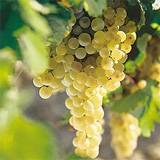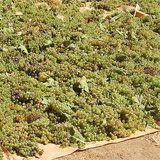Palomino is a white grape widely grown in Spain (particularly in the Jerez region), and best known for its use in the production of sherry. In Spain, the grape is split into the sub-varieties Palomino Fino, Palomino Basto, and Palomino de Jerez, of which Palomino Fino is by far the most important grape variety used for sherry.
The wine formed is low in both acidity and sugar which, whilst suitable for sherry, ensures that any table wine made is of a low quality, unless aided by acidification. In France, it is referred to as Listan, and in South Africa as Fransdruif or White French. It is also found in Australia and California where it is also used mainly to produce fortified wines. The wine 'must' has a tendency to oxidize quickly, a characteristic that can be ignored when used for sherry production.
Approximately 95% of the grapes grown for Sherry are Palomino. As varietal table wine, the Palomino grape produces a wine with very bland characteristics. The Albariza soil is the best for growing the Palomino grape, and by law 40% of the grapes making up Sherry must come from Albariza soil. The Barros and Arenas soil are mostly used for Pedro Ximenez and Moscatel grapes - both used exclusively for sweet Sherries.
Palomino originated in the Andalusia region of southern Spain and was supposedly named after one of King Alfonso X's knights. It is high yielding, producing about 80 hl/ha without irrigation and can reach as much as 150 hl/ha. Harvested in early September, the 'must' from the first pressing, the 'primera yema', is used to produce Fino and Manzanilla and the 'must' from the second pressing, the 'segunda yema' used for Oloroso; any additional pressings is used for lesser wines, distillation and vinegar. The 'must' is then fermented in stainless steel vats until the end of November, producing a dry white wine with 11-12% alcohol. The Palomino grape covers over 28,000 hectares throughout Spain. At one point in time, Palomino Fino was one of 100 different grapes used in Sherry production.











